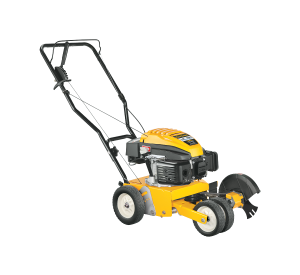By using the right techniques, edging your lawn creates well-defined boundaries between the turf, the surrounding pavement and landscape features to give your yard a beautiful finish. These tips will help you create well-defined edges on your property using your Cub Cadet string trimmer, edger, or a combination of the two.
Should I Use an Edger or String Trimmer?
Ask ten different lawn care professionals about the best way to edge and you’ll get ten different opinions. Some will only use a string trimmer, others will insist on using an edger, and some use a combination of the two. Each tool has its own advantages and disadvantages.
An edger can cut a deep, even trench into the soil, creating a clean edge that lasts a long time. In most cases, it will only need to be used every third or fourth time the lawn is mowed. On models that can tilt the blade, like the Cub Cadet LE100, it can also be used to get a finished surface around flower beds without resorting to hand edging.
A string trimmer is great for touching up a previously cut edge, and there’s no chance of cutting too far into the soil, guaranteeing a good finish around concrete. However, the line can’t dig that far into the dirt, so it doesn’t take long for grass to pop back up. Some professionals choose to work exclusively with a string trimmer because it means there’s one less piece of equipment they have to deal with, and they’ll already be using the trimmer for cutting around buildings and fence lines
Before and After Edging
Low voltage wire for outdoor lighting and lawn irrigation systems are usually deep enough to be well below the cutting edge of the blades, but underground pet fence can be as little as an inch from the surface, posing a major hazard. Make sure you know whether this wire has been buried and where it’s located before edging to prevent damage to the wire and your equipment.
If you edge the lawn before mowing, the mower can be used to pick up and remove loose dirt and grass clippings to get the best finish.
Edging with a String Trimmer
The trimmer should be held so that the head is perpendicular to the ground and the gas cap is pointing up. The engine is designed to work at any angle, and both the throttle handle and loop handle are designed to be used in this position.
Start by lowering the head toward the ground to create a thin trench. Once the string is cutting through the soil at the desired depth, start walking backward: as you cut, the line will spin down toward the soil, keeping the grass and dirt from being thrown into the air while creating an even cut.
Edging with a Blade Edger
Start by tilting the edger so that the blade is in the air. Engage the clutch and lower the blade into the soil until the front wheels are on the ground.
As the blade spins and cuts through the soil, it will gently pull the edger forward. Let this action do most of the work, pushing the edger forward only when the soil has been cleared from the cut. If the blade rides up over a tough spot, pull the edger back and roll over it again.
If you’re having trouble getting a clean cut next to concrete, lower the cutting height a little. By making the blade bite into more soil, it will track the edge of the pavement better.
Using the blade in the fully upright position provides a clearly defined line around pavement, but making a straight cut around landscaping features and flower beds will leave an unfinished-looking edge. To get a professional finish, go around the border with the blade straight, then make a second pass over the feature or bed with the blade angled out to the edge of the first cut. This will make the soil slope down toward the grass for a more natural look.
Keep Your Equipment Ready to Edge
When you need to service or repair your Cub Cadet, visit www.cubparts.com. We’re a certified dealer with a wide range of OEM parts in stock ready to be shipped across the U.S. and Canada. Our site makes it easy to find what you need by integrating factory parts diagrams and descriptions into our search system so you can see exactly what you’re ordering.

